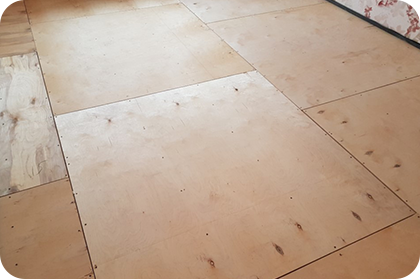In this article I want to consider sound insulation of floor joists. This construction is not the most popular, because usually a soundproofing floor involved at the stage of construction of a house or apartment, and put it under the screed of concrete. The floor joists are not the cheapest option, and for sound insulation "floating floor" is more effective and the choice of materials for sound insulation floor screed today is very wide, about them we wrote in previous articles.
Advantage of floor joists is to install in the apartment with repairs. Most often used in wooden houses, and homes with significant limitations of carrying capacity of slabs.
With the right device shows high values reduce the level of impact noise (30 dB) and is a good indicator of the additional airborne sound insulation (8-10 dB).

Design of floor joists is very simple. For this we need:
- The joists 50x50 mm
- Sheets of plywood 18 mm thick
- Material to fill the space between the joists – acoustic wool for sound insulation- will Somanet-EKO (or other similar sound-absorbing wool will Somanet MB/AKULite NEO),
- The elastomers Sylomer SR18 (fit under all the joists) and Sylomer SR55 (placed around the perimeter) to create the vibration-insulating strip, which will support the joists overlap.
- Tape Vibrotek-M
- Sealant EcoFLEX-sun
The wool is placed so that it slightly protrude above the joists, then pressed sheets of plywood. If you do it below the level of the plywood, you can get a "drum", and on this floor to go will not be very comfortable.
To all side surfaces (walls, columns and thresholds) of the floor structure is attached strip of Vibrotek-M in 2 layers to attach the plywood close to the wall and through the gasket to avoid vibrations being transmitted from the walls to the new floor. After all closes the first layer of plywood. This can be done at the same time, and put the wool, and close with plywood. So convenient to walk and not trample once again material.
 Plywood is laid in 2 layers that are glued together elastic rubber mastic.
Plywood is laid in 2 layers that are glued together elastic rubber mastic.
After I laid the first layer, all joints promazyvaetsya vibration-insulating one-component silicone sealant Acuflex-VS, designed for sealing joints and connections, which has excellent acoustic properties and high moisture - and temperature resistance.
After that, put the second layer of plywood. The seams of the two layers are made in extension, to give greater integrity, and greater rigidity.
The result is a very solid floor.
There are two types of sound insulation of floor joists with the use of Sylomer. They are characterized by the step of laying 300 mm and 400 mm between the joists.
The floor joists gives a fairly good increase in sound insulation from airborne noise (the cries of neighbors, music, TV, traffic noise outside the window) and impact (trampling, kicks, movement of furniture).
Solutions:
Soundproof floor joists with the use of Sylomer (step 300 mm)
Thickness: 100 mm
Index of reduction of impact noise ΔRw ≈ 8-10 dB
Index reduction of airborne noise level of ΔLnw ≈ 30 dB
The approximate cost is based on m2 - 615 UAH/m2
Soundproof floor joists with the use of Sylomer (pitch 400 mm)
Thickness: 100 mm
Index of reduction of impact noise ΔRw ≈ 8-10 dB
Index reduction of airborne noise level of ΔLnw ≈ 30 dB
The approximate cost is based on m2 - UAH 996/m2
You might ask why such a difference in price per m2? It's very simple. Sylomer SR18, which is placed under all the joists, much cheaper Sylomer SR55, which is placed around the perimeter. Accordingly, with the use of step 300mm you need less quantity of elastomer Sylomer SR18, and, accordingly, is used more Sylomer SR55.
The only difference between them - Sylomer SR 55 can withstand a greater static load of 0.055 N/mm2 and is used for vibration isolation of equipment and structures with an average weight and Sylomer SR 18 stand less static load is 0.018 N/mm2 and is used for vibration isolation of equipment and structures with light weight.
